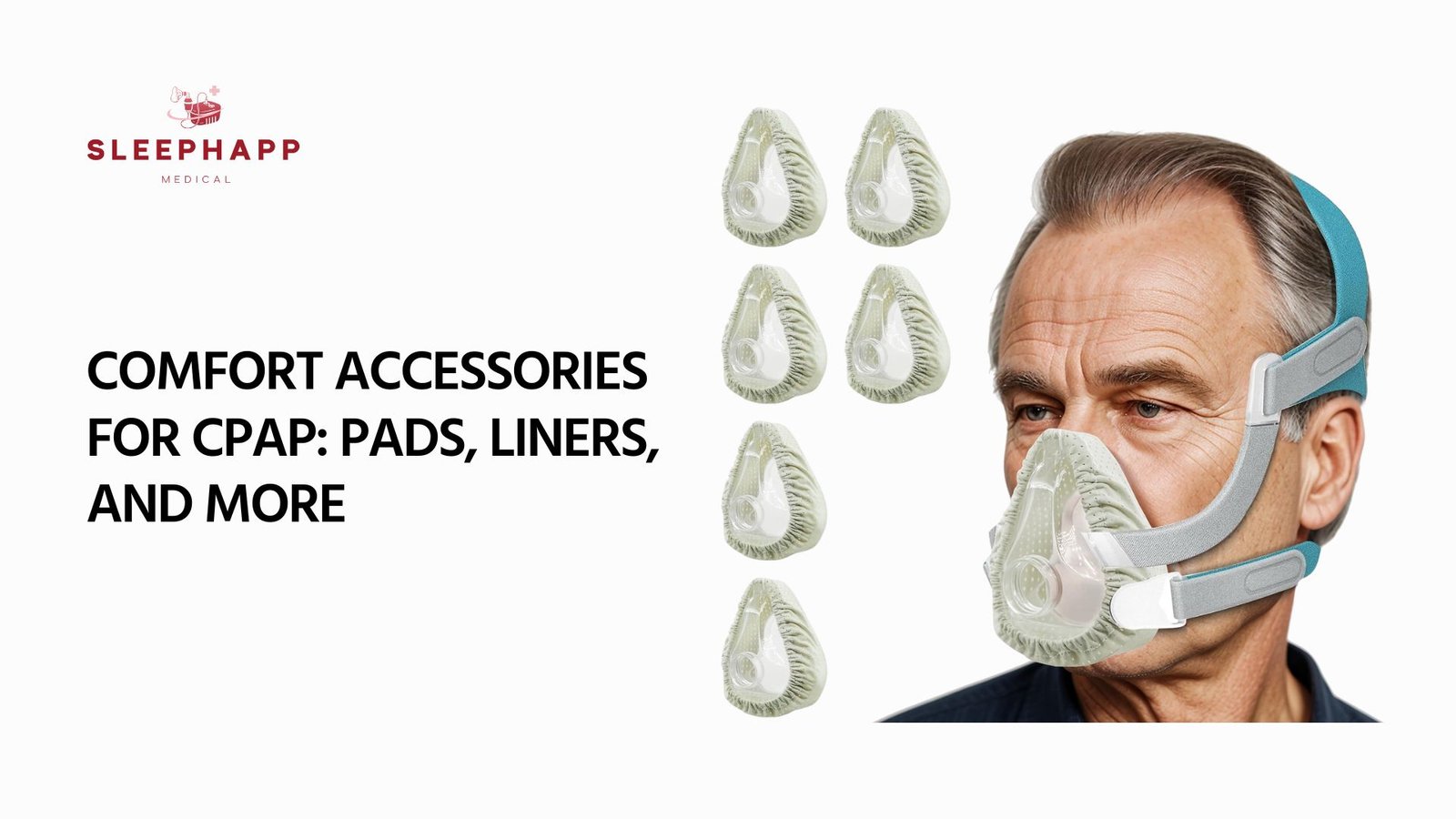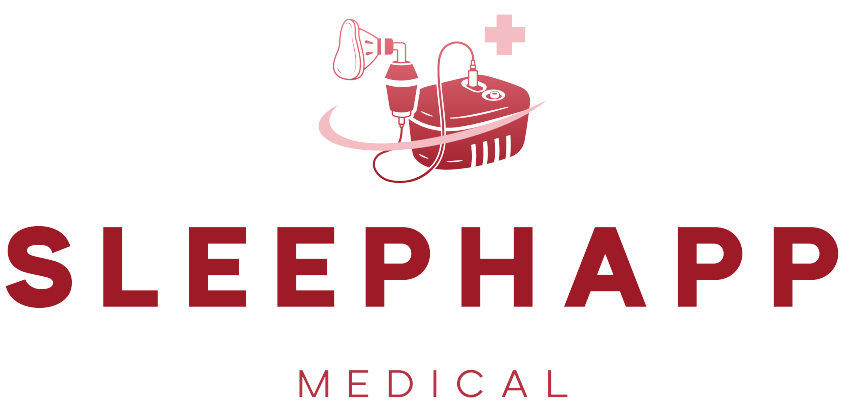Comfort Accessories for CPAP: Pads, Liners, and More
Home » Comfort Accessories for CPAP: Pads, Liners, and More

Table of Contents
If you want to make your CPAP mask more comfortable, we have the right accessories. To get the best from your CPAP therapy, using more than just the machine is essential. Accessories can make your therapy more comfortable and work better. They can also help you stick to your treatment if you have sleep apnea.
CPAP therapy is essential for people with sleep apnea. It helps them stay healthy. But some people find it hard to use. They might feel discomfort, have skin irritation, or deal with mask leaks.
Comfort accessories can help solve these problems. Things like pads and liners can make CPAP therapy more comfortable. These accessories improve the experience and make the treatment more effective.
In this article, we will talk about different CPAP comfort accessories. We will explain how they help and give tips on choosing and caring for them.
Importance of Comfort Accessories for CPAP
However, it can be uncomfortable for some, making it harder to use regularly. Comfort accessories help solve this problem. They make therapy more manageable and more effective. Below, we explain why these accessories are essential.
Helping People Stick to Therapy
Many CPAP users stop using therapy because it feels uncomfortable. Masks can irritate the skin or fit poorly. Accessories like mask liners, padded headgear, and nasal cushions make wearing masks easier. They reduce irritation and improve the fit.
Better Sleep Quality
Comfort accessories improve sleep for CPAP users. For example, mask liners stop air leaks, which can cause noise or irritation. Hose covers prevent “rainout,” or water buildup in the tubing.
These minor fixes can make a big difference. They let people sleep without being disturbed by equipment problems. Over time, better sleep improves health, mood, and energy.
Long-Term Advantages
Comfort accessories also protect your skin and CPAP equipment. Items like nasal pads and mask liners prevent skin rashes and redness. This helps keep your skin healthy.
Accessories like hose covers protect the tubing from damage, making it last longer. Mask liners keep masks cleaner, reducing the need for frequent replacements. These benefits save money and improve therapy quality.
Advanced Options for Better Comfort
Modern CPAP accessories offer even more benefits. Heated tubing prevents condensation and keeps the air warm. Aromatherapy kits add pleasant scents to the airflow, making therapy more relaxing.
Special CPAP pillows are designed to support masks and hoses. They allow users to sleep comfortably without disturbing the mask seal, improving therapy results.
Emotional Benefits
Comfort accessories don’t just help with physical problems. They also improve how users feel about their therapy. Comfortable equipment reduces frustration and anxiety. It allows users to see CPAP therapy as part of their bedtime routine, not a burden.
Types of CPAP Comfort Accessories
CPAP Mask Pads
CPAP mask pads sit between your skin and the mask’s silicone cushion, helping to prevent skin irritation and redness caused by CPAP therapy. CPAP therapy can sometimes feel uncomfortable, but a CPAP mask cover can make a significant difference in comfort. For more information on CPAP mask pads and comfort options, you can explore the available solutions that can enhance your therapy experience. Keeping the mask tight is essential to avoid air leaks, but for some individuals, sweating can cause the mask to slip and lose its grip.
CPAP Mask Liners
Mask liners are unique accessories used with CPAP masks. They fit between your face and the mask cushion. Their main job is to improve the mask’s seal. This helps deliver air properly without leaks. It also makes CPAP therapy work better. These liners are made from soft, breathable materials. They make the mask more comfortable and reduce pressure on your skin.
Types of Mask Liners
- Gel Mask Liners
- Fabric Mask Liners
- Foam Mask Liners
- Silicone Mask Liners
- Allergy-sensitive Mask Liners
- Moisture-wicking Mask Liners
CPAP Headgear Cushions
CPAP headgear cushions are an essential part of the CPAP therapy system. They help keep the CPAP mask in place while making it more comfortable. These cushions are made from soft materials like foam or fabric. They create a barrier between the mask straps and your head, preventing pressure and irritation.
CPAP Hose Covers
A CPAP hose cover is a cover that goes around the CPAP tubing. People with sleep apnea use it. The cover stops condensation from building up inside the hose. This helps prevent discomfort and mold growth. It also makes less noise, which can make sleeping more comfortable.
CPAP Pillow
CPAP pillows are not the same as CPAP nasal pillows, a type of small mask. CPAP pillows are made to fit around a CPAP mask. They come in different shapes, but most have cutouts or curves. These help people who use CPAP machines sleep on their side without the mask pressing into their face. Some CPAP pillows can be adjusted to help keep the mask in place. For more details on the best CPAP pillows and how they can improve your sleep, you can explore various options. A CPAP pillow can also improve treatment by keeping the mask from moving during sleep.
CPAP Chin Straps
A CPAP Chin Strap helps people with sleep apnea keep their mouths closed while using a CPAP machine. The CPAP machine treats sleep apnea by keeping the airway open. The strap goes around the chin and head to stop the mouth from opening during sleep. This helps the CPAP machine work better and keeps air pressure in the airway. The strap reduces air leakage, making the therapy more effective. It is adjustable for a good fit and made from soft, breathable material for comfort. This simple solution helps improve sleep and treatment.
CPAP filters
CPAP filters are essential parts of the CPAP machine. They catch airborne particles and help provide clean air. You should change the disposable filters every so often. Also, clean the reusable filters regularly. This keeps the machine working well. Clean filters improve air quality and reduce the chance of breathing problems.
CPAP Accessories Maintenance Tips
Take care of your CPAP (Continuous Positive Airway Pressure) equipment. It helps the device work well and keeps it clean. Good maintenance also makes your CPAP last longer and keeps you healthy. Follow these simple tips to care for your CPAP accessories.
Check Your Equipment Regularly
Check your CPAP mask, tubing, and headgear often. Look for cracks, leaks, or tears in the mask. For tubing, check for small holes, fraying, or discoloration. Make sure the headgear is not stretched or worn out. Worn parts can affect your therapy.
Tip: Replace damaged parts as soon as you notice them.
Store It Safely
Store your CPAP equipment in a safe place. Please keep it in a cool, dry area away from sunlight. Use a storage bag to protect it from dust. Do not place heavy items on top of the equipment or tubing. This can damage it.
Tip: Check the storage area for moisture or pests regularly.
Take Care of the Humidifier
If your CPAP has a humidifier, clean it properly. Always use distilled water to avoid mineral buildup. Empty and rinse the humidifier chamber every day. Let it air dry thoroughly. Clean it once a week with soap and warm water.
Tip: Replace the humidifier chamber every 6 months or sooner if it is cracked or discolored.
Follow Instructions
Every CPAP machine and accessory is different. Check the user manual for specific cleaning and care instructions. Use only parts that are compatible with your machine. This will help it work properly.
Tip: Keep the manual handy for quick reference.
Replace Accessories on Time
Replace your CPAP accessories regularly.
- Replace the mask cushion every 1-3 months.
- Replace the mask frame and headgear every 6 months.
- Replace tubing every 6-12 months.
- Replace filters as recommended. Disposable filters usually last 1-2 months.
Tip: Write down the replacement dates or set reminders to stay on schedule.
Care for the CPAP Machine
Don’t forget to clean the machine itself. Wipe the outside of the device with a damp cloth. Check the power cord and other connections for any damage. Get the machine serviced by a professional if needed.
Tip: Keep the machine on a stable, elevated surface to avoid water spills.
Cleaning Schedule for CPAP Accessories
It’s essential to keep your CPAP accessories clean. This helps your therapy work well and keeps everything safe and hygienic. For more information on CPAP accessories that improve sleep therapy, you can explore different options.Here is a simple cleaning schedule for your CPAP equipment.
Daily Cleaning
Masks and Headgear
After every use, wash your mask and headgear with warm, soapy water. Use a mild, fragrance-free soap to avoid skin irritation. Rinse everything well under water to remove soap. Let them dry in a clean, dry place.
Cleaning them daily stops oils, sweat, and bacteria from building up. This helps avoid skin irritation and keeps your therapy working well.
Weekly Cleaning
CPAP Tubing
Unplug the tubing from both the machine and mask. Soak it in warm, soapy water for 10–15 minutes. Use a tube brush to clean the inside. Rinse it well and hang it to dry.
This cleaning helps stop mold and bacteria from growing in the tubing.
Humidifier Chamber
If your CPAP has a humidifier, empty the water chamber every day. Once a week, wash the chamber with soapy water. Rinse it well and let it dry completely.
Cleaning the humidifier helps stop mold and bacteria from growing.
Monthly Cleaning
Air Filters
Check the filters every month. If the filter is dirty, replace it. Some filters can be washed and reused, while others are disposable. Make sure the filter is dry before putting it back.
Clean filters help keep the air flowing properly. They also stop dust and allergens from affecting your therapy.
CPAP Hose Covers
If you use a hose cover, wash it once a month. Follow the manufacturer’s instructions for cleaning. Usually, you can wash it with warm, soapy water. Dry it thoroughly before using it again.
Choosing the Right Accessories for Your Needs
When selecting CPAP accessories, consider factors like:
- Your specific needs
- The type of CPAP machine you have
- Personal comfort preferences
- The durability and quality of the accessory
- Ease of cleaning and maintenance
- Compatibility with your CPAP equipment
- Cost and budget considerations
Make sure to try each accessory. See how it fits into your routine. Check if it solves the problems you face with CPAP therapy.
Conclusion
Buying CPAP accessories can make your therapy better. It can help you sleep more comfortably and improve your sleep quality. Regular maintenance and careful cleaning are essential. Picking the right accessories for your needs is also key to making your CPAP treatment work well. Talk to your doctor or CPAP supplier for advice that fits your needs.
